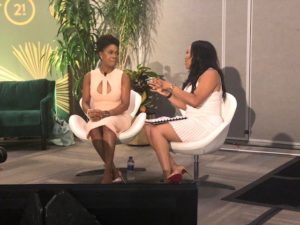Everybody talks. And every body talks, too. We don’t even need to say a thing because our bodies can reveal details about our thoughts and feelings in a flash.
As social psychologist Amy Cuddy says, “We make sweeping judgements and inferences from body language.”
Good body language–in the form of a calm face or friendly eye contact–can defuse a tense situation. Powerful body language–from standing up straight to power posing–can increase your confidence and make you appear more assertive.
Poor body language, on the other hand, can make you seem weak, powerless, and unsure of yourself. If you’re not careful, your body language can lead you astray.
As a Confidence Coach, my main goal is to assist you in refining your leadership skills, and that includes improving your body talk because the two concepts go hand-in-hand like peanut butter and jam.
Body language for leaders is an important concept that is often neglected in leadership skill development conversations. We focus on clear verbal communication, yet skimp on the importance of nonverbal communication. But if you’re looking to refine your leadership skills, then you must be aware of your body language.
As a leader, your body language should convey confidence, assertiveness, attentiveness, and power because your purpose is to achieve goals, inspire action, listen, learn, and hold yourself and others’ accountable.
If you’re struggling to reach the level of confidence you desire, then the following body language tips can help you regain a sense of control over your own body talk and help the strong, powerful leader in you really shine.
Body Language for Leaders Tip #1: Find Your Go-To Facial Expression
Do you tend to wear your feelings on your face? If so, then it’s not the end of the world because it can serve you well in happy, social situations where you express excitement over the birth of a friend’s baby or celebrate a family member’s birthday.
However, you do  need to be aware that wearing your feelings on your face can have negative consequences, especially in certain professional settings.
need to be aware that wearing your feelings on your face can have negative consequences, especially in certain professional settings.
If you’re facing a particularly tough and tense professional situation, for example, then showing your frustration through squinted eyes and pursed lips can backfire. It can curb your ability to listen and solve whatever problem or disagreement that might have surfaced.
As a leader, you need to learn how to control your nonverbal communication, including your face. You don’t want to be an emotionless robot, but you do want to express a certain level of attentiveness and calm through your body language.
I encourage you to find a go-to facial expression that you can rely on in difficult situations so that you do not reveal your true feelings.
Your go-to face doesn’t necessarily mean you need to be smiling as someone is criticizing you, but it does need to show that you can remain unbothered by unexpected and tense situations.
It’s your job to manage the mood and demeanor that you bring into a room. Having a go-to facial expression can help you regulate your behavior and by extension your own feelings since you’ll give yourself time to consider the situation at hand rather than simply reacting to it.
Body language choices are as much about you as they are about how other people perceive you.
To figure out your go-to facial expression, think about what brings you peace. For me, I like to think about sitting on a beach or getting a massage. It’s during times like these when I’m at my most relaxed and when my face settles into soft, calm, and inviting features.
A soft, calm, inviting face is exactly what I want to put forward when totally unrelaxing times are going down.
I use this go-to face to keep myself centered so that I can get through tough situations. I also use it to show that I’m unfazed by setbacks.
That’s the power of language–it’s power you give to yourself, and power you put back out into the world, showing everyone that you’re ready for anything that life throws at you.
Body Language for Leaders Tip #2: Embrace Power Posing
Along with identifying and owning your go-to facial expression, you’ll also want to develop a repertoire of power poses.
Power posing is a concept that stormed into the mainstream spotlight thanks to Amy Cuddy and her now famous TED talk on how body language can shape your emotions and who you are.
In her TED Talk, Cuddy specifically calls out examples of good body language and poor body language in the form of high-power poses and low-power poses.
High-power poses, like outstretched arms, express confidence and strength while low power poses, such as a hunched back, express protection and increase feelings of stress.
When you’re in leader mode, you want to exude confidence, not shy away from it. Yet your body language could betray you, as Cuddy shows.
If you’re touching your neck and holding onto your arms as you’re speaking to either your boss or your direct reports, then you’re showing them that you’re not particularly confident in whatever decision you’re making or even simply being yourself around them.
You need to break these bad body language habits ASAP because they’re not serving you or your leadership goals. Throw out your low-power poses and embrace power posing instead.
Power posing, or taking up a relaxed and open stance like one of these, can help you not only exude more confidence but also feel more confident. It’s a way to show that you value yourself, and that you are a capable and competent leader.
While power posing won’t solve all of your problems, it will help you manage your own emotions. So next time you feel yourself shrinking inward, I challenge you to channel your nervous, anxious energy into a strong, open posture.
You need to pull yourself out and forward because no one else is going to do it for you. You gotta own it, live it, be it.
Body Language for Leaders Tip #3: Practice Active Listening
Once you’ve got your go-to face and your power poses down pat, then you need to work on showing that you’re a present and respectful leader because expressing confidence is not enough.
A good leader is confident, but a great leader is also respectful. One of the best ways to show that you respect others is through active listening.
Active listening in and of itself isn’t body language, but you can use good body language to convey that you’re actively listening to someone else.
Some examples of active listening body language include:
- Leaning toward someone who is speaking to show that you’re being attentive to their words.
- Mimicking a speaker’s body language to show that you feel comfortable around them.
- Maintaining an open posture while someone is talking so that you convey that you’re inviting of what they have to say.
- Keeping eye contact so the speaker knows you’re paying attention to them.
In order to practice active listening body language, you need to deeply analyze when you need to listen and when you can give feedback.
You need to determine if you are providing value to a conversation or simply interrupting inappropriately because you’re not really listening to what the other person has to say.
You might have the best idea/thought/statement in the world to share, but sometimes you need to force yourself to show restraint in order to show respect.
If you’re really dying to express yourself, try writing down your thought and then immediately get back to active listening.
Active listening is harder said than done, so try out just one of the active listening body postures from the list above to start and then continue building on your success.
Through active listening, you can embrace the leader in you and the leader in others–now that’s a win-win!
Additional Body Language Resources
If you’re interested in learning more about body language, check out the following resources:
- Your Body Language May Shape Who You Are (a TED Talk by social psychologist Amy Cuddy)
- The Ultimate Guide to Body Language (a Psychology Today article by Dr. Susan Krauss)
- The Silent Language of Leaders: How Body Language Can Help–or Hurt–How You Lead (a book by Dr. Carol Kinsey Goman)
- Presence: Bringing Your Boldest Self to Your Biggest Challenges (a book by Amy Cuddy)
Until Next Time,
Jacqueline M. Baker



